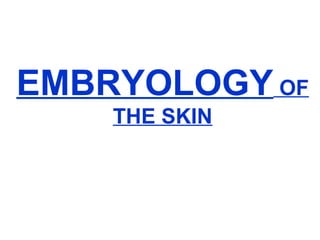
The Embryology Of The Skin
- 2. Juxtaposition of two major embryonic elements. Prospective epidermis from surface area of the early gastrula: 1- Prospective mesoderm, brought into contact with the undersurface of the inner surface of the epidermis during gastrulation. 2- Mesoderm is essential for differentiation of epidermal structures such as hair follicles and maintenance of adult epidermis. Neural crest participates by pigment cell small bulk.
- 3. EPIDERMIS: i) 3rd week of fetal life: ingle layer of glycogen filled undifferentiated cells Periderm. ) 4 – 6 weeks old: Fetus two layers are present: A) Periderm or epithilium (purely embryonic structure ultimately lost in utero). Stratum germinativum.
- 4. EPIDERMIS (Continued): iii) 8 – 11 weeks (crown –rump 26 -50 mm): a middle layer is formed.Glycogen still abundant in all layers. Few microvilli appear at the surface.
- 5. EPIDERMIS (Continued): iv) 12- 16 weeks (crown –rump 69-102 mm): Mitochondria Gogli compleses Few tonofilaments Numerous microvilli From this stage on dome shape blebs start to project from the centre of the periderm. One or more intermediate layers of cell appear with:
- 6. EPIDERMIS (Continued): vation of periderm cast off in amniotic fluid vernix caseosa. 24 week: ratohyaline granules appear in the higher layer 23 week: ermediate layers increase in number. 16 – 26 weeks:
- 7. EPIDERMIS (Continued): Desmosomal proteins at basal layer distinguishable by the10th week. sal keratins are expressed by 14th week. lagrin by the 15th week. The periderm participates in the uptake of carbohydrates from the amniotic fluid.
- 8. HAIR FOLLICLES & APOCRINE GLANDS: 3. Down growth 2.Nuclei elongated 1.Basal cells become high. Crowding of nuclei at basal layer of epidermis hair germ or Pregerm. This stage rapidly passes into germ stage characterized by: Earliest appearance 9th week: Eyebrows, upper lip and chin. Basal keratins are expressed by 14th week.
- 9. HAIR FOLLICLES & APOCRINE GLANDS (Continued): At the same time: 1. Mesenchymal cells and fibroblasts increase in number to form hair papilla beneath the germ. 2. Outer cells of hair peg become coloumner in shape and arranged radially to the long axis. 3. Oblique growth downwards with the advancing axis becoming bulbus gradually enveloping the mesodermal papilla.
- 10. HAIR FOLLICLES & APOCRINE GLANDS (Continued): At this stage( Hair peg ) Two epithelial swellings at the posterior wall of the follicle appear. In many hair follicles a third pulp appear above the sebaceous rudiment to form the apocrine gland found in scalp ,face chest, abdomen, legs, axillae, mons pubis, external auditary meatus, eyelids. 2. The upper becomes the rudiment of the sebaceous gland. 1. The lower becomes the arrector pili muscle.
- 11. HAIR FOLLICLES & APOCRINE GLANDS (Continued): As peg grows: Cells of inner root sheath develop above the matrix. Matrix grows down. Inner cells grow upwards to form the hair canal.
- 12. HAIR FOLLICLES & APOCRINE GLANDS (Continued): Hair follicles are arranged in a specific pattern: No new follicles develop in adult skin. No large scale destruction of follicles during postnatal development. Only increase in density as the body surface increases. Groups of three at fixed interval 274-350 micrometer. As skin grows groups become separated and new rudiments appear at a critical distance dependant on the region of the body.
- 13. SEBACEOUS GLANDS: Solid hemispherical protuberance on the posterior surface of the hair peg with moderate amount of glycogen. Large and functional again at adult life. After birth size rapidly reduced. SG become differentiated at 13—15 Gland is large and functional------sebum and vernix caseosa Cells in the centre soon accumulate droplets of fat.
- 14. ECCRINE GLANDS: Start to develop about three months. Palms and soles initially. Lumens form by dissolution of dismosomes. Intraepidermal ducts form by coalescence of groups of intracytoplasmic Cavities. 14th to 15th week tips penetrate deeply into the dermis, while in the epidermis coloumns of distinct cylindrical layer elongated and curved pass outwards. Cells are oblong palisading and lying close together. Rudiments identifiable as regularly spaced undulations of stratum germinativum.
- 15. NAILS: Develop in the third month. 16—18 week (Cr R 120—150 mm) keratinizing cells from both dorsal and ventral matrixes can be distinguished.
- 16. MELANOCYTES: Develop from the neural crest. Lose themselves in the mesenchyme before 4 - 6 month of gestation and travel to the basal layer. Some may get arrested in the dermis. Merkel Cells: Found in glaborous skin finger tips, gingival lips, nailbeds and other regions by the 16th week. Langerhans cells: Derived from monocyte-macrophage lineage, enter the epidermis about 12weeks.
- 17. DERMIS: Origin: Ventrolateral part of the somaite dermatome, however; Most of the dermis come from cells migrating from other parts of the mesenchyme. Embryonic dermis is at first very celluar and up to 2nd month is indistinguishable from subcutis. Blood vessels, connective tissue, fibroblasts, mastcells and fat cells also arise from mesonchyme.
- 18. DERMIS (Continued): Soon regular bundles of collagen appear at the end of the third month. By the 22nd week Elastic fibres and islands By the 5th month papillary and reticular dermis become distinct. Hair root sheath appear.
- 19. DERMIS (Continued): Cells of the dermis: Undersurface is smooth at first, At 4 month with the appearance of hair follicles becomes irregular. 14 - 21 Weeks: Numerous fibroblasts, perineural cells, pericytes, merkel ,mast cells, langerhans and histiocyte. 14th weeks: three types of cells, stallate, macrophage and granular secretory (melanoblasts or mast cells).
- 20. DERMIS (Continued): Hemidesmosomes 3rd month DEJ; Lamina densa 2nd month In these areas papillary ridges which determine dermatoglyphics take their place. Touch pads at fingers and toes reach maximum development at 15 weeks. After that they flattem and become indistinct.
- 21. THANK YOU